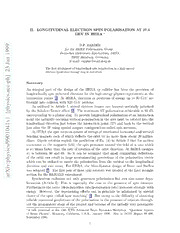
II. Longitudinal Electron Spin Polarisation at 27.5 GeV in HERA PDF
Preview II. Longitudinal Electron Spin Polarisation at 27.5 GeV in HERA
II. LONGITUDINAL ELECTRON SPIN POLARISATION AT 27.5 GEV IN HERA a 9 D.P. BARBER 9 for the HERA Polarisation Group. 9 1 Deutsches Elektronen–Synchrotron, DESY, 22603 Hamburg, Germany. n a E-mail: [email protected] J 3 The firstattainment oflongitudinalspinpolarisationina highenergy 2 electron (positron) storage ring is described. ] h p Summary - c c An integral part of the design of the HERA ep collider has been the provision of a . longitudinally spin polarised electrons for the high energy physics experiments at the s c interaction points [1]. At HERA, electrons or positrons of energy up to 30 GeV are i s brought into collision with 820 GeV protons. y h As outlined in Article I, stored electron beams can become vertically polarised p by the Sokolov–Ternov effect [2]. The maximum ST polarisation achievable is 92.4% [ corresponding to a planar ring. To provide longitudinal polarisation at an interaction 1 point the naturally occuring vertical polarisation in the arcs must be rotated into the v 1 longitudinal direction just before the interaction point (IP) and back to the vertical 4 just after the IP using special magnet configurations called spin rotators. 0 1 At HERA the spin rotators consist of strings of interleaved horizontal and vertical 0 bending magnets each of which deflects the orbit by no more than about 20 millira- 9 dians. Dipole rotators exploit the prediction of Eq. (4) in Article I that for motion 9 / transverse to the magnetic field, the spin precesses around the field at a rate which s c is aγ times faster than the rate of rotation of the orbit direction. At HERA energies i s aγ is between 60 and 68. So it can be arranged that small commuting deflections y h of the orbit can result in large noncommuting precessions of the polarisation vector p which can be utilised to rotate the polarisation from the vertical to the longitudinal : v direction and vice versa. For HERA, the Mini-Rotator design of Buon and Steffen i X was adopted [3]. The first pair of these spin rotators was intalled at the East straight r section for the HERMES experiment. a Synchrotron radiation not only generates polarisation but can also cause depo- larisation (Article I). This is especially the case in the presence of spin rotators. Furthermore the ratio: (depolarisation rate/polarisation rate) increases strongly with energy. However, the depolarising effects can in principle be minimised by special choice of the optic called ‘spin matching’ [4]. But owing to the difficulty of obtaining reliable numerical predictions of the polarisation in the presence of rotators through- out the preparatory stage of the project and because of the initially very pessimistic a A talk presented at the 15th ICFA Advanced Beam Dynamics Workshop: “Quantum Aspects of Beam Physics”, Monterey, California, U.S.A., January 1998. Also in DESY Report 98–096, September 1998. 1 predictions, it was by no means clear that longitudinal polarisation could be obtained even after spin matching. Nevertheless, on the first attempt with the rotators switched on at the chosen energy of 27.5 GeV, a longitudinal electron polarisation of about 56% was attained. This is to be compared with the 65% polarisation attained immediately beforehand with the rotators turned off. This was the first time in the history of high energy storage ring physics that longitudinal polarisation had been attained. Space limitations prevent my giving more details here but complete information and diagrams can be found in [1]. Subsequently longitudinal polarisationlevels of about 70% for periods of up to ten hoursforpositronsincollisionwithtensofmilliampsofhighenergyprotonshavebeen achieved. Furthermore by measuring the polarisation of individual positron bunches the influence of the beam–beaminteraction onthe polarisationhasbeen observed and found to be exotic. For example positron bunches in collision with protons can have a higher polarisation than non–colliding bunches and the polarisation of both groups of bunches is very sensitive to the tunes of the machine. Obviously, complicated resonance phenomena are at work [5]. Outlook In the year 2000 two more pairs of spin rotators will be installed so that three HERA experiments can work with longitudinally polarised electrons or positrons. References 1. D.P. Barber et al., Phys.Letts., B343, 436 (1995). 2. A.A. Sokolov and I.M. Ternov, Sov.Phys.Dokl., 8 N012, 1203 (1964). 3. J. Buon and K. Steffen, Nucl.Inst.Meth., A245, 248 (1986). 4. D.P. Barber and G. Ripken, “Handbook of Accelerator Physics and Engineer- ing”, Eds. A.W. Chao and M.Tigner, World Scientific, in preparation. 5. D.P. Barber, Proc.13th Int.Symp. High Energy Spin Physics, Protvino, Russia, September 1998. World Scientific (1999). Also as DESY report 98-182 (1998). 2
